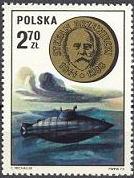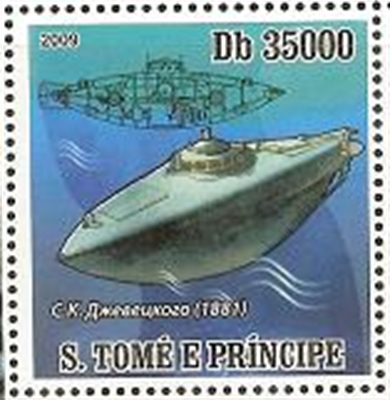|
Stefan Karlovich Dzhevetskiy (1844-1938), Russian submarine pioneer
 As had been the case during the Crimean War, the Russo-Turkish War of 1877 proved to be a great stimulus for the development of naval weapons, including submersible crafts. As had been the case during the Crimean War, the Russo-Turkish War of 1877 proved to be a great stimulus for the development of naval weapons, including submersible crafts.
Stefan Karlovich Dzhevetskiy was among the most outstanding Russian inventors and pioneers in submarine development. Dzhevetskiy`s first experimental submersible designated No.1/Type 1, was built, Blanchaire`s plant, and tested at the Black Sea port of Odessa in 1877. It was a small, one man`s craft propelled by a single shaft turned by pedals. It was the inventor himself who tested the submersible during five months in 1878, once almost perished during some accident.
The diminutive submersible attracted sufficient attention for the government to request Dzhevetskiyto construct a better model. His No.2/Type 2 was constructed in 1879 at Nevsky plant in St. Petersburg. Slightly larger then its predecessor , the No.2 could accommodate 4 persons and was propelled by 2 shafts-one forward and one aft, again turned by pedals. The forward shaft could be oriented in the vertical plans and the aft in the horizontal plane, thus allowing the propellers to assist in steering and in diving or surfacing the craft. To allow the shaft this flexibility, a spherical joint was fitted, at the time it was known as the Goubet system, named after the French designer Claude Goubet. Under water maneuvering was further assisted by sliding weights used in bow and stern compartments. The craft was also fitted with an optical periscope.
After the spectacular demonstration of his underwater boat to the Tsar Alexander III and Empress Maria Fedorovna on Silver Lake in Gatchina, Dzhevetsky received a governmental order for the construction of 50 underwater boats of the third variant intended for coastal defense. Referred as the No.3/Type 3 these submarines were built through 1881, also at St. Petersburg. One was left to Dzhevetsky for further improvement. Now this craft can be seen in the Central Naval Museum in St. Petersburg. Unfortunately, she is empty inside – none of the mechanism was preserved.
The No.3 design was very similar to the No.2 but propelled by only one shaft, again turned by pedals. 
These submersibles were not considered to be very satisfactory crafts. In 1884 one of them was equipped
with a 1.8 hp. Electric motor powered by a storage battery, permitted a speed of 4 knots for a submerge endurance of 10 hours, probably the first submarine craft to be propelled exclusively by electric power. Craft crew was reduced to 2; a periscope and an air-regeneration system were provided. Another Type 3 unit was fitted with a one hp. Motor and a water jet propeller.
These two modifications are believed to have been the last Dzhevetsky units to be built; he went on designing and constructing semi-submersibles and surface boats for the Russian government.
Specifications for No.1 (1887):
Displacement (srf/sub tons): un known
Dimensions (L*B*D feet): 14`9*4`11*4`11
Propulsion: treadle driven, one shaft
Speed (srf/sub knots): un known /1.5
Range (srf/sub miles@knots): un known
Diving depth (feet): un known
Complement: 1crew member
Torpedo: none
Mines: 2
Armament: none
Specifications for No.2 (1879) and No3 (1881):
Displacement (srf/sub tons): un known/2.5
Dimensions (L*B*D feet): 19`8*4`11*3`3
Propulsion for No.2/No.3: bow and stern treadles with propellers/ treadle, one shaft
Speed for No.2/No.3 (srf/sub knots): un known /2, un known/3
Range (srf/sub miles@knots): un known
Diving depth (feet): un known
Complement: 4 crew members
Torpedo: none
 |
Poland |
1973 |
Stefan Dzhevetskiy (1844-1938) and his submarine |
 |
Saint Thomas |
2009 |
Submarine designed by S.K.Dzhevetskiy (1881), his No.3/ Type 3 |
|